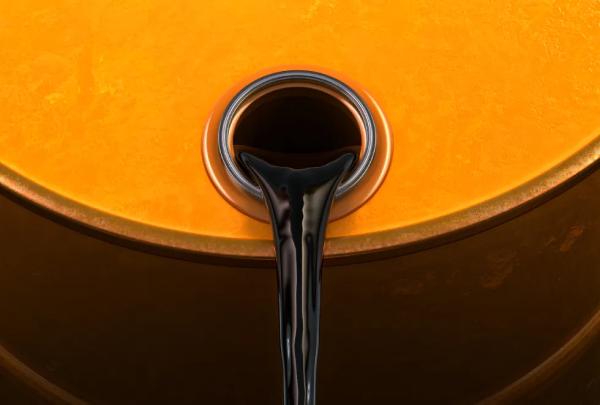We continue Fair Observer’s new feature focused on the shifting landscape of international payments and one of the major dramas of this decade: dedollarization. It began as a private dialogue between members of our team and experts in our circle who are keenly tuned into the mysteries of our monetary and banking systems. Our dialogue that began in April continued with a new contribution from Alex. By

As has become clearer in recent months, any discussion of the dollar and its place in the history of the late twentieth and early twenty-first century must take into account a curious entity that emerged exactly 50 years ago: the petrodollar. Alex opened the debate with the following message:
Shortly after our email exchange I came across the chart below, and it led to an epiphany. Iranian Oil production over the past 3 years. Let me explain.
Over a short time period, Iranian crude oil production increased by roughly 50%, from around two to around three million barrels per day (mbpd) — which is not much in the big scheme of global oil (estimated at 103 mbpd). But the oil market is extremely sensitive to small imbalances between supply and demand.
Why? Oil is a toxic substance. Once it’s out of the ground, it needs to be stored or transported. Oil storage is expensive relative to its value. Salt caverns are the cheapest means of storage, around $0.50 per barrel per month. In periods of oversupply, those fill up first. Then it’s above-ground storage, $0.50–$1.50 per month. Then it’s storage “at sea” (on oil tankers), which can be up to $2.50 per month. Just when there is too much oil, storage gets expensive. So you could see oil trading at $40, and annual storage cost at 12 x $2 = 24. It eats up more than HALF of the value of your oil! In one year!
That’s why there is no limit to how low the price of oil can fall (even turning negative briefly during COVID). The place of delivery for West Texas Intermediate crude oil futures is Cushing, Oklahoma, a landlocked place far away from any ocean. If you bought one crude oil futures contract at a negative price, you’d think this would be a great thing. But no. You now have to take delivery of 1,000 barrels (159,000 liters) of a toxic substance in Cushing. All the above-ground oil storage bins (seen here from space) are full, and so are the pipelines. You now have a huge problem.
Supply does not react quickly to price swings. A $1 billion offshore rig requires a bunch of highly skilled engineers, often making $200,000 a year. If you shut that rig down, you lay off those engineers. You might never be able to get them back once production is projected to restart. That’s why you just keep producing, no matter what.
The same applies to demand. After oil in storage has been depleted, prices rise. Are you going to stop driving to work because gasoline prices went up 50 cents? Who will choose to take cold showers or not fly to that conference? Maybe you will begin to consider carpooling if gasoline prices double or triple. A huge price move is needed before demand destruction can begin. That’s why oil prices are so volatile. Supply and demand are quite inelastic.
Because demand is so hard to control, it’s important to control supply. The Saudis can reportedly produce at $2 a barrel. US shale is profitable only above $40–$60. To become a major oil producer, and, recently, major exporter of hydrocarbons, the US requires a high oil price. How do you ensure a high oil price? You need to suppress other countries’ production to prevent imbalances.
It is therefore no surprise that countries with the largest oil reserves in the world (Venezuela, Russia) are heavily sanctioned. Venezuela is sitting on the largest oil reserves in the world! Yes (almost) none of it gets extracted!
The Saudis are exempted. They are our “friends.” They play the role of safety valve whenever there is an oil shortage. For this privilege, they (rather, the royal family) are loyal to the US. They pay for this privilege by purchasing large amounts of US weapons/fighter jets, etc., and by accommodating Israel.
Iran and Iraq have the potential to produce six million barrels per day. This would upset the apple cart. It needs to be prevented. A war between these two countries (1980–1988), if it could happen once again, would be the “easiest” way. (Of course, it won’t happen again). Which brings us back to Iran and its recent increase in oil production. The US needed a reason to go after Iran’s oil industry. Nuclear must go, too. Probably less out of fear of nuclear armament than the fact that nuclear power plants would decrease domestic consumption of hydrocarbons and therefore increase Iran’s export potential.
The US didn’t want to bomb Iran directly, probably out of fear of retaliation. Hence it got Israel to do it. Israel needed a pretext, hence the (unprovoked) attack on the Iranian embassy in Damascus. It was clear that Iran would have to respond. The provocation was intended. In exchange for attacking Iran, Israel gets a free hand in Gaza. The twisting and turning of the US press secretary, Admiral John Kirby, as he deflects any criticism of Israel’s actions speaks volumes.
It’s about the oil. Always has been, always will be. Contrary to common belief, the US does not want a low oil price. It needs a high oil price. It needs it first of all to make domestic production possible, and second, to force non-US oil importers to purchase dollars — to pay for oil, which is traded in US dollars (USD). This is the only way to run large twin deficits (fiscal and trade) without killing the currency.
Alex has taken us into the thick of things, revealing a deeper logic about why the US needs to defend the dollar’s pre-eminent position in global markets. He thus reminds us that there is one market that is still literally the lubricant of all markets and the international payments system as a whole.
Ed Quince responded to Alex a few days later, noting that the poker game around oil does indeed occupy the central position, which leads him to question Washington’s style of play. If it is truly interested in maintaining the dollar’s dominance over time, logic would require that it change that style. He offers some practical advice to the decision-makers in Washington, which probably will not be followed. Even if it were, he sees the projected lifespan of the “almighty dollar” as just ten more years at best.
Just one point to watch: If the folks in power in the USA are truly responsible and want the dollar to retain its reserve currency status a little longer, Russian, Chinese, Iranian and Venezuelan banks should be invited, lured, pulled, coerced or forced back into USD-denominated energy trade.
Doing so will probably buy the dollar another decade, give or take — it’s hard to tell exactly. Not doing so intensifies the ongoing and accelerating flight to other currencies.
At this point, only a complete rollback of all unilateral (and therefore illegal) economic sanctions and the de-weaponization of the Western financial system can save the USD. A law or, better yet, a constitutional amendment comprehensively prohibiting the use of the dollar and finance as a weapon is needed to achieve this goal. Since this is extremely unlikely, the end of the dollar’s dominant position is something we will unfortunately witness in our lifetime.
One could argue that the fundamental factor upholding the dollar’s status — namely, trust in American, British and European finance — has eroded. Run.
Alex responded to Ed’s pessimism by reminding him that he had in his possession a book from the 1970s with the title The End of the Dollar. He added these thoughts:
Doesn’t mean it won’t eventually happen. Just saying that the USD has been declared dead for a long time.
He agreed with Ed that the propensity of the masters in Washington to confiscate USD reserves can only increase the motivation of BRICS+ countries to search for alternatives. But he insists that any alternative will encounter some serious obstacles.
Somebody has to supply a reserve currency (RC) to other countries. This can happen in 3 ways:
The dollar is, of course, being weaponized, but it remains an extremely convenient means of exchange for so many participants in the world economy.
Pricing commodities in currencies other than USD would be a first step. Still, that leaves the problem of supplying whatever new currency would serve as RC. China, as a net exporter, has a trade surplus, which makes it difficult to export its currency. With a relatively closed capital account, it is very unlikely to attract financial flows.
The Eurozone has an open capital account, but is also a surplus area.
I don’t see any other currency that exists today to be able to serve as an alternative to the USD.
An “artificial” currency, like the IMF’s Special Drawing Rights, or something partially backed by gold might work, but it would, of course, require a broad consensus among trading partners (which might fail because of the US veto).
Join the debate
The debate rages on. This is not simply about which choice of payment is more attractive or more efficient. As both Alex and Ed demonstrate, the geopolitical dimension will continue to play a determining role. When it comes to the way the world works, Bill Clinton’s adviser James Carville is wrong: It isn’t “the economy”; it’s the geopolitics, “stupid!” Or, rather, as Alex and Ed have pointed out, it’s the place where economics and geopolitics meet.
Money Matters…, is dedicated to developing this discussion and involving all interested parties.
We invite all of you who have something to contribute to send us your reflections at [email protected]. We will integrate your insights into the ongoing debate. We will publish them as articles or as part of the ongoing dialogue.
*[Fair Observer’s “Crucible of Collaboration” is meant to be a space in which multiple voices can be heard, comparing and contrasting their opinions and insights in the interest of deepening and broadening our understanding of complex topics.]
Source: fairobserver.com



